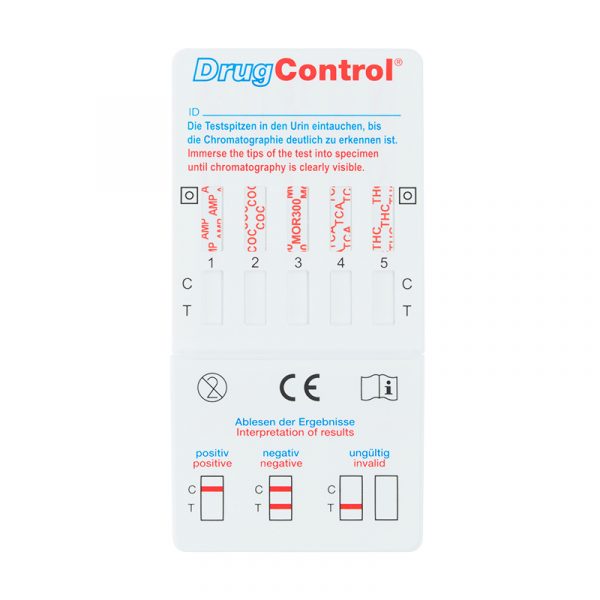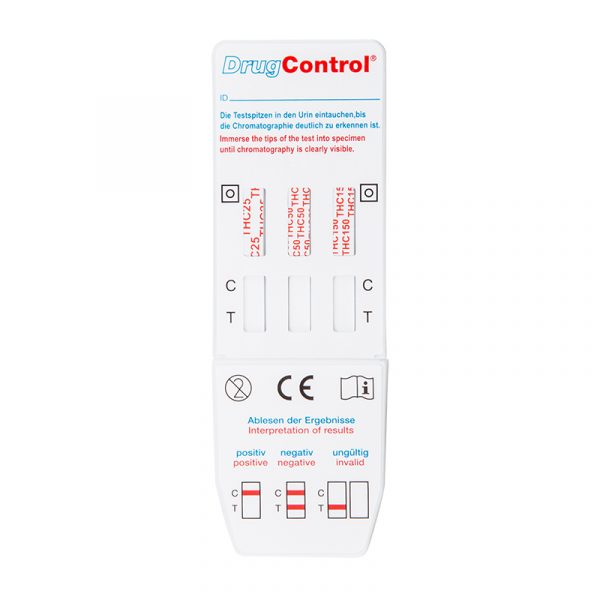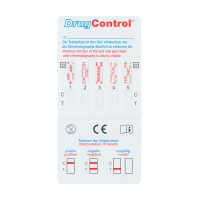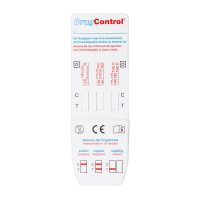Multi Parameter Dip Test
- Article ID
- 008SLXXX
- manufacturer
- ulti med Products (Deutschland) GmbH
- Handling time
Product description
The ulti med Test is a specific arrangement of different lateral flow chromatographic immunoassays for the detection of drugs in human urine.
Principle
The ulti med MULTI DrugControl Test is an immunoassay in which chemically labelled drugs (drug-protein conjugates) compete for limited antibody binding sites with drugs which may be present in urine. The test device contains membrane strips which are pre-coated with drug-protein conjugates on the test band(s). Each strip, the drug antibody-colloidal gold conjugate pad is placed at one end of the membrane. In the absence of drug in the urine, the solution of the colored antibody-colloidal gold conjugate move along with the sample solution upward chromatographically by capillary action across the membrane to the immobilized drug-protein conjugate zone on the test band region. The colored antibody-gold conjugate then attach to the drug-protein conjugates to form visible lines as the antibody complex with the drug conjugate. Therefore, the formation of the visible precipitant in the test zone occurs when the test urine is negative for the drug. When the drug is present in the urine, the drug/metabolite antigen competes with drug-protein conjugate on the test band region for the limited antibody. When a sufficient concentration of the drug is present, it will fill the limited antibody binding sites. This will prevent attachment of the colored antibody (drug-protein conjugate)- colloidal gold conjugate to the drug-protein conjugate zone on the test band region. Therefore, absence of the color band on the test region indicates a positive result.
A control band with a different antigen/antibody reaction is added to the immunochromatographic membrane strip at the control region (C) to indicate that the test has performed properly. This control line should always appear regardless of the presence of drug or metabolite. If the control line does not appear the test device should be discarded.
Adulteration
Adulteration is the tampering of a urine specimen with the intention of altering the test results. The use of adulterants can cause false negative results in drug tests by either interfering with the screening test and/or destroying the drugs present in the urine. Dilution may also be employed in an attempt to produce false negative drug test results.
One of the best ways to test for adulteration or dilution is to determine certain urinary characteristics such as
- Oxidants/PCC
- Specific Gravity
- pH
- Nitrite
- Glutaraldehyde
- Creatinine
These assays provide only preliminary analytical test results. An alternate chemical method must be used in order to obtain a confirmed analytical result. Gas chromatography/mass spectrometry (GC/MS) or liquid chromatography/mass spectrometry (LC/MS) are the preferred confirmatory methods. Clinical consideration and professional judgement should be applied to any drug of abuse test result, particularly when preliminary positive results are used.
Benefits:
- adulteration parameter test available
- alcohol detection of ETG or enzymatical alcohol detection (0.2 to 3.0 per mill)
- up to 12 (2×6) single parameter possible
The minimum order quantity for the test are 1,000 pieces.











